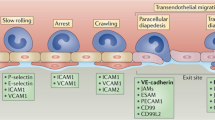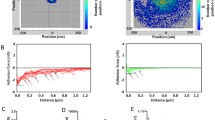Abstract
A mathematical model which describes adhesion of bacteria to host cell lines is presented. The model is flexible enough to account for the following situations: extracellular bacteria are either in exponential or in stationary phase. Adhesion is described as a reversible binding process in which the bacteria attach to or detach from specific receptors uniformly distributed on the cell surface. In turn, attached bacteria can either replicate or, conversely, they are restrained to remain in stationary phase. In the first case, however, we must consider the problem of whether the decrease of unoccupied receptors as adhesion progresses imposes a limit to the replicating capacity of the attached bacteria. The effect exerted by the multiplicity of infection (MOI), i.e. the ratio of the number of bacteria to the number of host cells, on the process of adhesion is also contemplated by the model. This has revealed that experiments performed at the same values of MOI can show completely different levels of adhered bacteria, depending on the number of host cells in the assays. This finding demonstrates that the report of the MOI values is insufficient to characterize comparative studies of bacterial adhesion since it could lead to a misunderstanding of the corresponding data. Simplified models based on the steady-state approximation and in equilibrium analysis by means of a Lagmuir adsorption isotherm for the attached bacteria are also discussed. This allows us to define the adhesion coefficient (β) in a given bacterium-cell system so that, with the exception of those systems where these coefficients cannot be defined, larger values of β are related to a greater adhesion capacity. An overview of the procedures to perform quantitative adhesion data analysis is outlined. Finally, theoretical predictions are compared with experimental results from the literature.
Similar content being viewed by others
References
Bliska, J. B., J. E. Galan and S. Falkow. 1993. Signal transduction in the mammalian cell during bacterial attachment and entry.Cell 73, 903–920.
Doig, P., T. Todd, P. A. Sastry, K. K. Lee, R. S. Hodges, W. Paranchych and R. T. Irvin. 1988. Role of pili in adhesion ofPseudomona aeruginosa to human respiratory cells.Infect. Immun. 56, 1641–1646.
Doyle, R. J., J. D. Oakley, K. R. Murphy, D. McAlister and K. G. Taylor. 1985. Graphical analyses of adherence data. InMolecular Basis of Oral Microbial Adhesion, S. E. Mergenhagen and B. Rosan (Eds), pp. 109–113. Washington, DC: American Society for Microbiology.
Elomaa, O., M. Kangas, C. Sahlberg, J. Tuukkanen, R. Sormunen, A. Liakka, I. Thesleff, G. Kraal and K. Tryggvason. 1995. Cloning of a novel bacteria-binding receptor structurally related to scavenger receptors and expressed in a subset of macrophages.Cell 80, 603–609.
Falkow, S. 1991. Bacterial entry into eukaryotic cells.Cell 65, 1099–1102.
Falkow, S., R. R. Isberg and D. A. Portnoy. 1992. The interaction of bacteria with mammalian cells.Ann. Rev. Cell. Biol. 8, 333–363.
García-Peñarrubia, P., A. D. Bankhurst and F. T. Koster. 1989. Experimental and theoretical kinetics study of antibacterial killing mediated by human natural killer cells.J. Immunol. 142, 1310–1317.
Gibbons, R. J., E. C. Moreno and D. M. Spinell. 1976. Model delineating the effects of a salivary pellicle on the absorption ofStreptococcus meiteor onto hydroxyapatite.Infect. Immun. 14, 1109–1112.
Hoepelman, A. I. M. and E. I. Tuomanen. 1992. Consequences of microbial attachment: directing host cell functions with adhesins.Infect. Immun. 60, 1729–1733.
Ingraham, J. L., O. Maaloe and F. C. Neidhart. 1983.Growth of the Bacterial Cell. Sunderland, MA, Sinauer Associates, Inc.
Isberg, R. R. 1991. Discrimination between intracellular uptake and surface adhesion of bacterial pathogens.Science 252, 934–938.
Isberg, R. R. and J. M. Leong, 1990. Multiple β 1 chain integrins are receptors for invasion, a protein that promotes bacterial penetration into mammalian cells.Cell,60, 861–871.
Isberg, R. R. and G. Tran Van Nhieu. 1994. Two mammalian internalization strategies used by pathogenic bacteria.Ann. Rev. Genet. 27, 395–422.
Kaufmann, S. H. E. 1992. Immunity to intracellular bacteria.Ann. Rev. Immunol. 11, 129–163.
Kusters, J. G., G. A. W. M. Mulders-Kremers, C. E. M. Van Doornik and B. A. M. Van der Zeijst. 1993. Effects of multiplicity of infection, bacterial protein systhesis, and growth phase on adhesion to and invasion of human cell lines bySalmonella typhimurium.Infect. Immun. 61, 5013–5020.
MacBeth, K. J. and C. A. Lee. 1993. Prolonged inhibition of bacterial protein synthesis abolishedSalmonella invasion.Infect. Immun. 61, 1544–1546.
Morris, E. J. and B. C. McBride. 1984. Adherence ofStreptococcus sanguis to saliva coated hydroxyapatite: evidence for two binding sites.Infect. Immun. 43, 656–663.
Tran Van Nhieu, G. and R. R. Isberg. 1993. Bacterial internalization mediated byβ 1 chain integrins is determined by ligand affinity and receptor density.EMBO J. 12, 1887–1895.
Wolfram, S. W. 1991.Mathematica. A System for Doing Mathematics by Computer. Reading, MA: Addison-Wesley.
Author information
Authors and Affiliations
Rights and permissions
About this article
Cite this article
Gálvez, J., Lajarin, F. & García-Peñarrubia, P. Mathematical modeling of adhesion of bacteria to host cell lines. Bltn Mathcal Biology 59, 833–856 (1997). https://doi.org/10.1007/BF02459995
Received:
Accepted:
Issue Date:
DOI: https://doi.org/10.1007/BF02459995




